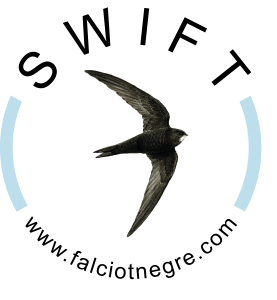Inappropiate diets for insectivores
NON-INSECT BASED DIETS ARE CONSIDERED INAPPROPIATE AND HARMFUL
It is essential to be aware of the poor results and risks on the survival of chicks hand-reared using wrong diets (Meat, pet food, grain, lactic formulas, fly maggots, …)
It can be establish that poor growth observed on insectivore chicks hand-reared with non-insect diets is clearly a husbandry matter related specifically to the diet.
Almost all show a stunted appearance when compared to their conspecifics hand-reared with insects.
Low body weight or poor growth may be caused by any factor that interferes with the homeostasis of the nestling; improper feeding (insufficient energy, unbalanced nutrition or inappropriate diet).
Nestling nutrition is the most obvious mechanism that influences growth and body size and it is a major factor in the husbandry management for any species, particularly nestlings as growth is the period in which most nutrients are necessary at their maximum levels.
In young altricial nestlings, the energetic cost of growth is often more than 50 per cent of the daily metabolizable energy requirements.
Birds are very sensitive to acute deficiencies of some nutrients. Insectivore chicks under non-insect diets show poor growing rates, clearly fed with a diet that differs significantly from its natural food.
Nutritional status of a growing bird is based on its ability to assimilate and metabolize the supplied food.
Insectivores, as other faunivores birds rely on a very competent digestive enzymatic capacity. Animal food prey is high in protein with a balance in essential amino acids, similar to the bird’s requirements.
In terms of nutritional components, insects are high in proteins and lipids, with the amino acid balance almost as good as vertebrate prey, with good sources of phosphorus, vitamins, and trace minerals but low in calcium.
Looking at a non-insect diet (e.g.: cat food), we can establish that could be complete in terms of macro-nutrients, with proteins and lipids contents similar to those observed in insect diets.
Despite these similarities, nutritional strategies determine the types of food that may be consumed without digestive or metabolic complications, hence species are adapted to foods that are attainable and can be metabolized appropriately by an adapted digestive tract.
Insectivore birds have a moderate rate of passage, with an efficiency of digestion that approaches 100 per cent of the non-chitin components of insects.
On the other hand, carnivore birds have a slow rate of passage, an adaptation to complete efficiently the digestion of vertebrate prey.
A Common swift or another insectivore bird fed with a carnivore diet may have less opportunity to assimilate and metabolize the food completely.
A theoretically balanced diet may appear to have all required nutrients, but in fact it is nutritionally inadequate due to the interaction of specific nutrients.
This imbalance may be caused by excessive nutrient impairing the metabolism of another functionally similar nutrient, causing a decrease in its absorption or increasing its catabolism or excretion.
When observing the feather quality; non-insect diets produce a poor plumage and usually cause dirtiness on feathers. Flight performance at release, done in subjective terms by observation, is questionable (hardly they manage to fly high).
Numerous birds on non-insect diet show retained feather sheaths along the hand-rearing process and needed manual preening. Even doing so, fault-bars at the spot where the sheath constrict the feather leave a weakened structure.
Birds rely on two major sources of energy, lipids from fat stores and proteins. If they do not have enough lipids, they may start protein catabolism in a stage when proteins are fundamental for the development of vital organs and muscles.
Adipose tissue is not observed in chicks on non-insect diet, conversely to the birds in insect diets. The fat deposit is important to avoid formation of fault-bars, defective barbule formation which may be points of breakage in the feathers.
If fat stores are depleted, birds start a compensatory use of protein catabolising muscle tissue. This effect can cause the release of endogenous corticosterone, detrimental while feather is developing. Other researchers observed on passerines how endogenous corticosterone released under physical stressors (e.g.: food restriction) resulted in greater inter-barb distances in primaries, secondaries and rectrices, fewer barbules and weaker feathers when compared to control birds.
Body weight and plumage condition are essential indicators of individual chances of survival to release. Low fledgling body weight can lead to low fitness, thus decreased chances of survival. Common swifts need an exceptional body condition at fledgling.
They need considerable flying abilities and therefore a large pectoral mass.
Apparently young spend the first night after fledging on the wing and may start on the migration shortly after leaving the nest, a long journey crossing the Sahara to the wintering fields in Africa, migrating at high altitudes, often above 2000 m.
Common swifts require adaptation to execute fast movements in low atmospheric levels and restless flight usually at high altitudes with low oxygen pressure, which represents great energy expenditure.
Dull plumage, which may consist of severely malformed feathers, cannot supply flight performance, necessary insulation or waterproofing.
NEITHER OF THESE INHIBITED GROWTH RESULTS CAUSED BY WRONG DIETS, LOW BODY WEIGHT AND POOR FEATHER CONDITION, SEEM COMPATIBLE WITH SURVIVAL IN THE WILD
Probably only a small percentage of even wild-raised nestlings survive to reproduce. We can not provide for need of orphaned Common swifts as their parents do, but we must emulate them as close as possible if we want to give them any chance at all of survival, initially its long migration journey, and then successfully to reproductive age.
BSc (Hons) MSc Enric Fusté MRSB

